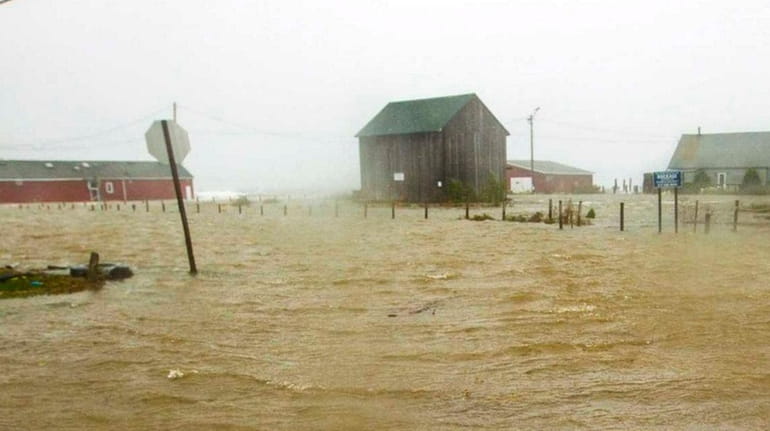In the crosshairs of looming disaster

Flooding along the streets of New Suffolk during superstorm Sandy in 2012. Credit: Randee Daddona
About a year ago, my students at Hofstra University and I embarked on a research project to determine whether the use of immersive technology could improve hurricane preparedness. Would experiencing a Category 3 hurricane in virtual reality make people more likely to evacuate in the event of a real storm on Long Island?
The answer, when we conducted our research on campus, was yes.
So when we took our project on the road this spring — to a coffee shop in Long Beach, a city devastated by superstorm Sandy in 2012 — we expected similar results. Surely, residents who had lived through that storm would have been evangelized by the experience.
Instead, we found a different kind of conversion.
Despite witnessing extensive damage to their homes and broader beachfront community, many Long Beach residents were steadfast in their assertions that they had survived Sandy, and thus would be able to ride out the next storm.
“I already lived through a hurricane in reality,” one man told us. “I do not need to experience one in virtual reality.”
This kind of response represents one of several obstacles meteorologists, emergency planners, and public officials face in attempts to improve hurricane resilience in New York.
Unlike places like the Carolinas, which recently experienced the brunt of Hurricane Florence’s wrath, the Northeast has longer periods between hurricane landfalls, which can result in laxer regulations and decreased public understanding of their impacts. Before Sandy struck in 2012 as a post-tropical cyclone with hurricane force winds, the last time a hurricane made landfall in New York or New Jersey was Gloria in 1985.
As a result, many residents of vulnerable coastal locations did not take the proper long-term precautions, such as purchasing flood insurance policies, nor the prudent short-term actions, such as protecting their homes and heeding evacuation messages.
Further, development continues unabated in those vulnerable areas, placing more people and property in harm’s way, many of them new residents unaware of the risk associated with living in a hurricane-prone location. Past climatology indicates that in any given year, a major hurricane (Category 3 or greater on the Saffir-Simpson Scale) could threaten New York.
Eighty years ago this month, the 1938 “Long Island Express” made landfall in Suffolk County as a Category 3 storm with 120-mph winds.
A repeat of this storm — a matter of when, and not if — would likely break current records for costliest United States hurricane and could result in significant fatalities, too.
The Long Island Hurricanes Symposium at Hofstra University on Wednesday, will examine ways to better understand past storms, assess our forecasting techniques, and identify shortcomings in our preparedness for the next “big one.”
This symposium is only a starting point, however.
To avert looming disaster, it is vital for local and national governments, the media, and others with outsized influences to more heavily promote scientific literacy, sustainable planning, and disaster preparedness as it relates to hurricanes. Such actions will allow for smoother, more efficient action when Long Island next finds itself in the crosshairs of a hurricane.
Jase Bernhardt is a meteorologist and an assistant professor of geology, environment and sustainability at Hofstra University.
